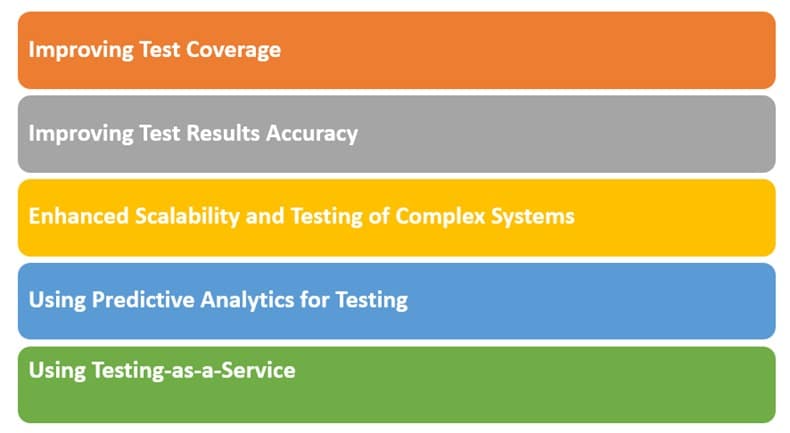Accelerate Success with AI-Powered Test Automation – Smarter, Faster, Flawless
Start free trialA Journey with Sam: Transforming Testing Challenges with AI
Meet Sam – a passionate and dedicated software engineer. His goal was to create a revolutionary banking application. Driven by this vision, he excitedly entered the development process and started building the application.
Sam’s Traditional Testing Challenges
While Sam developed the application’s features, he soon started facing challenges in the area of traditional testing.
Manually testing each feature took a lot of time and effort, which delayed and slowed down development. With each new feature addition, the scope of the testing changed and soon Sam was facing scalability problems. He started facing issues while integrating with continuous integration/continuous deployment (CI/CD) pipelines. He wasn’t able to test the application’s complex scenarios with manual testing and conventional automation tools. Soon regression testing was also prone to errors, especially with his large codebases.
As the pressure to adhere to tight release schedules increased, Sam realized that traditional testing approaches were becoming a hindrance in his pursuit of a seamless banking application.
Enter AI Testing – Sam’s Path to Success
Just when Sam thought he had failed, AI-powered testing appeared as a glimmer of hope. With the help of AI and ML algorithms, he was able to analyze data, identify patterns, predict potential defects, and even automate regression testing and test case generation.
Let us see how AI Testing helped Sam overcome each of his traditional testing bottlenecks.

Success Factor 1: Improving Test Coverage
The Challenge: Traditional testing methods struggled to cover all possible scenarios, positive and negative cases, including the edge cases. This resulted in gaps in test coverage and potential defects in the application. It’s also a time-consuming and resource-intensive process.
The AI way: AI can automatically generate test cases by analyzing the application’s requirements, historical data, and any patterns in user behaviors. AI Testing can also help you prioritize test cases according to their impact and probability of failure. This saves time and effort by eliminating the need for manual test case generation.
Success Factor 2: Improving Test Results Accuracy
The Challenge: To avoid being left behind, teams need to release faster – that means, they need to develop faster, test faster, and fix defects faster! Human testers are prone to errors as they manually create and execute each test case, leading to slower release cycles and increased risk of inaccurate test results – and not to forget the time-consuming process.
The AI way: AI testing can minimize human errors by automating repetitive tasks and following pre-defined testing patterns, allowing testers to focus their efforts on more challenging features and Exploratory Testing. This results in an improved testing efficiency.
Success Factor 3: Enhanced Scalability and Testing of Complex Systems
The Challenge: Today’s applications are complex and integrated with AI, ML, IoT devices to provide ‘anytime, anywhere’ services. Traditional testing methods struggle to adapt and keep up the pace with these advancements, resulting in longer testing cycles and reduced agility.
The AI way: Continuous testing helps you to identify errors that might otherwise be invisible in large software systems and helps to avoid the costs of business disruption.
With cloud-based testing platforms and virtualized environments, you can test your applications across various devices, browsers, and platforms. By integrating IoT automated testing, teams can validate the reliability of applications, identify any patterns, and monitor potential threats.
Success Factor 4: Using Predictive Analytics for Testing
The Challenge: Traditional testing is reactive – identifying and correcting the defects AFTER they have been found by the business or end-users. This involves huge costs to fix them.
The AI way: By using machine learning algorithms, predictive analytic tools can help you to anticipate future defects based on historical data patterns. You can save enormous amounts of time in diagnosing and Defect Triaging. Self-healing capabilities help you to resolve any failures in regression tests quickly.
Success Factor 5: Using Testing-as-a-Service
The Challenge: Success in today’s digital age depends on how well businesses can develop new features. Traditional testing can’t handle this pressure without amplifying the cost of resources or jeopardizing the time-to-market.
The AI way: Testing as a Service leverages cloud infrastructure and advanced AI capabilities reducing the operational expenses and increasing on-demand testing services. TaaS solutions are scalable, can create test cases and test scripts, and also keep them up-to-date.
Take The Next Step: Webomates and AI
Sam and his team no longer fear the bottlenecks of testing but instead embrace them as opportunities for innovation, growth and enhancements. You too can use AI to increase your efficiency and stay one step ahead of the competition.
Introduce your team to Webomates AI-based software testing to speed up your product releases and generate business value.
- See how our advanced intelligent automation helps to continuously test your build across platforms and devices.
- Explore our AI Testing tools and services to reduce error-prone manual testing with patented AI Defect Predictor tool
- No Code. No Script. Low Touch. AI automates your application in just 3 steps.
To find out more about what Webomates Intelligent Testing services can do for your business, get In touch with us today.
Please click here and schedule a demo, or reach out to us at info@webomates.com
Tags: AI Testing, Test Automation, Traditional testing challenges

Leave a Reply